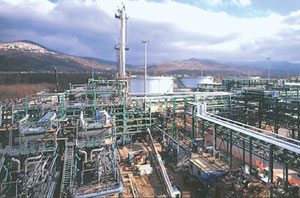Italy: Eni sets an Italian record
Apr. 2002 Vol. 223 No. 4 European Technology Round Up
Hydrocarbon deposits in Val d’Agri and the Sauro Valley are the most important energy resource ever discovered in Italy, and Eni has invested about 1.8 billion euros there, with a very precise aim – committing itself to economic development and protecting the environment. The first discovery was made in 1981, and it is estimated that the Val d’Agri reservoir holds reserves of 490 MMboe. A second reservoir, Tempa Rossa, was discovered in 1987 in the Sauro Valley, some 20 km from Val d’Agri. Reserves there are estimated at 415 MMboe; and in March 2001, Eni began a 12-month production test to define its development. In April 1996, the Monte Alpi Oil Center at Viggiano went into operation. At Val d’Agri, Eni works in joint venture with Enterprise Oil, while in the Sauro Valley, a JV has been set up with Enterprise, ExxonMobil and TotalFinaElf, in which Eni is operator. The total investment for the Val d’Agri project is about 1,500 million euros; for Tempa Rossa, it will be 300 million euros. The discovery immediately boosted employment in support industries, in which 1,500 people already work.
Working together for the environment, safety. Eni is committed to carrying out all activities in full respect of the environment and creating value for the local economy. To achieve this, it has reached an agreement with the Basilicata Region, also on behalf of its partner, guaranteeing that the most advanced technologies will be used and the environmental impact minimized, with a whole range of recovery, restoration and reforestation actions. A network has also been created to monitor oil activities, supported by the Environmental Observatory set up by the Region. To promote industrial growth – seizing the opportunities offered by the oil industry and its side businesses – the Region has decided to set up a development company, Eurosviluppo Basilicata, in which Eni will also invest. Finally, Eni will set up a chapter of the Eni Enrico Mattei Foundation in the Region with the aim of creating a knowledge center on resource management, environment and new technologies. Production startup was scheduled for the end of 2001, at 45,000 bopd, with a gradual increase to 104,000 bopd. Forty wells will be drilled in Val d’Agri; and the Monte Alpi Oil Center will be upgraded to receive the new production. The pipeline to transport the oil from the wells to the Oil Center and the pipeline connecting the Center to the AgipPetroli refinery in Taranto have been completed. The wells, Oil Center, pipelines and refinery have all been designed and constructed in compliance with strict safety standards and with the lowest possible impact on the ecosystem. The wells, Oil Center. Twenty-four of the 42 planned wells have been completed, and the remaining 18 will be completed by the end of 2005. The directional drilling technique was used with long, horizontal-borehole sections, thus minimizing the number of locations – there will be only 26 surface locations for the 42 wells. The wellheads have been installed below the ground to reduce visual impact; and all the rigs will use electricity rather than diesel-powered engines to reduce noise and polluting emissions. Some 200 km of pipeline are being laid underground to connect the wells to the Center, following routes chosen to avoid rock excavation. The pipelines can be inspected using sophisticated electromagnetic tools, and they are coated and monitored to check for corrosion. The first stage of the Monte Alpi Oil Center expansion work began in May 1999. By the end of 2001, it had a capacity of 45,000 bopd; at the beginning of 2003, this will increase to 104,000 bopd. Associated gas and water are removed from the crude at the Center and stored. The treatment circuit is completely isolated from the environment. The safety system is particularly innovative and is designed around the "dual barrier" principle, so that any failure at the Center will activate the automatic reset of functions and safe operating conditions. If this system fails, a second system will intervene and block production. The Monte Alpi-Taranto pipeline. This pipeline will transport Val d’Agri production from the Viggiano Oil Center to the Taranto refinery. The pipeline has been designed to guarantee safe transportation conditions, even in the case of seismic events, while fully respecting the environment. The pipeline is laid 2 m below ground, is 136 km long and will have a transportation capacity of more than 150,000 bopd. Automatic valves are installed every 5 km to control the flow and isolate sections in the event of anomalies. Sensors are placed along the route to monitor the oil flow. Excavation activities at archaeologically interesting sites indicated by the Agency have been supervised by archaeologists, and the important finds made are displayed at the District Museum in Potenza. At the end of the pipelaying work, the territory will be restored to its original condition. For Tempa Rossa, agreements signed with the Basilicata Region may be amended to include production of this reservoir, and facilities already planned are able to treat the oil and transfer it to Taranto. The development activities will last four years and envisage: construction of an Oil Center able to handle 50,000 bpd at Corleto Perticara; a connection system to the seven wells (five of which have already been drilled); a 7-km pipeline from the Center to link the pipeline with Taranto; and a storage deposit for the LPG produced, together with the oil and methane. The project will be developed with the same attention to the environment as that in Val d’Agri. |
|||||||||||||




